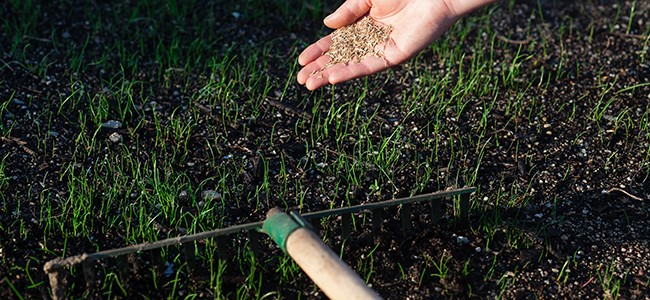
Any lawn, no matter how well cared for, can develop low spots, uneven patches and bare spots. Whether they’re caused by erosion or the ground settling around pipes or other installations, they can typically be resolved by top-dressing. Top dressing is also a good time to add organic matter to your soil. Here’s how to top-dress and reseed your lawn.
You can buy a high quality top-dressing mixture at your garden center, or make your own. To create your own, use a mixture of loam or topsoil, compost or peat, and sand. The proportions of these will vary depending on your lawn; for sandy soil, use more topsoil and compost, and for clay soils, increase the sand and compost to improve the soil composition.
If you’re top-dressing the entire lawn rather than a few problem areas, it’s a good idea to aerate beforehand. This will help the organic matter work its way into the soil, reduce compaction, and provide channels for air and water to reach the roots.
To apply the top-dressing, work in a few square feet at a time. Make a small mound of top-dressing on the lawn (2-4 shovels full) and spread it across the grass. The back of a garden rake is a good choice. Cover low spots and work it into the aeration holes. Ideally, you want a layer between half an inch and an inch over the grass. Work it until the grass begins to peek though the soil and the layer is even. Then flip your rake over and use the tines, raking until the top dressing settles on the soil.
For low spots that will require more than two inches of top dressing, remove the existing sod. Simply covering the existing grass can lead to underground decay, which can damage new grass and cause the ground to settle again. The sod can be replaced once you’ve filled the low spot. In extreme cases, you may need a multi-year plan, top dressing a couple of inches a year to gradually build the spot up to the level of the lawn.
Once the entire lawn is top-dressed and even, give it a gentle watering and check your low spots for settling. Smooth away bumps, and fill in any divots. If you dug sod out of low spots, replace it. (Learn how to choose the right sod for your lawn.)
The existing grass can grow through up to an inch of top-dressing, but if you had thin grass or bare spots, now is the time to reseed. The organic matter in the top-dressing will provide nutrients to the seedlings as they sprout and fill in.
Top dressing and reseeding is most effective in early spring, when cooler air temperatures and warmer soil temperatures will promote growth. Early fall is also a good time; you just need to allow enough time for new growth and to be able to mow three or four times before dormancy sets in.
For more lawncare tips, check out Exmark’s Backyard Life.






